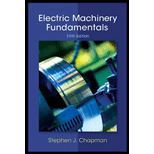
Electric machinery fundamentals
5th Edition
ISBN: 9780073529547
Author: Chapman, Stephen J.
Publisher: MCGRAW-HILL HIGHER EDUCATION
expand_more
expand_more
format_list_bulleted
Textbook Question
Chapter 1, Problem 1.15P
A transformer core with an effective mean path length of 6 in has a 200-turn coil wrapped around one leg. Its cross-sectional area is
Expert Solution & Answer
Want to see the full answer?
Check out a sample textbook solution
Students have asked these similar questions
I need help with this problem and an explanation of the solution for the image described below. (Introduction to Signals and Systems)
I need help with this problem and an explanation of the solution for the image described below. (Introduction to Signals and Systems)
I need help with this problem and an explanation of the solution for the image described below. (Introduction to Signals and Systems)
Chapter 1 Solutions
Electric machinery fundamentals
Ch. 1 - What is torque? What role does torque play in the...Ch. 1 - What is Amperes law?Ch. 1 - What is magnetizing intensity? What is magnetic...Ch. 1 - How does the magnetic circuit concept aid in the...Ch. 1 - What is reluctance?Ch. 1 - What is a ferromagnetic material? Why is the...Ch. 1 - How does the relative permeability of a...Ch. 1 - Prob. 1.8QCh. 1 - What are eddy current losses? What can be done to...Ch. 1 - Why are all cores exposed to ac flux variations...
Ch. 1 - What is Faraday law?Ch. 1 - What conditions are necessary for a magnetic field...Ch. 1 - What conditions are necessary for a magnetic field...Ch. 1 - Prob. 1.14QCh. 1 - The linear machine in Figure 1-19 is running at...Ch. 1 - Just how does a decrease in flux produce an...Ch. 1 - Will current be leading or lagging voltage in an...Ch. 1 - What are real, reactive, and apparent power? What...Ch. 1 - What is power factor?Ch. 1 - Prob. 1.1PCh. 1 - A flywheel with a moment of inertia of 4kgm2 is...Ch. 1 - A force of 10 N is applied to a cylinder of radius...Ch. 1 - A motor is supplying 50Nm of torque to its load....Ch. 1 - A ferromagnetic core is shown in Figure P1-2. The...Ch. 1 - A ferromagnetic core with a relative permeability...Ch. 1 - A two-legged core is shown in Figure P1-4. The...Ch. 1 - A core with three legs is shown in Figure P1-5....Ch. 1 - A two-legged core is shown in Figure P1-4. The...Ch. 1 - A wire is shown in Figure P1-7 that is moving in...Ch. 1 - Repeat Problem 1-10 for the wire in Figure P1-8.Ch. 1 - Prob. 1.12PCh. 1 - A core with three legs is shown in Figure P1-10....Ch. 1 - A two-legged magnetic core with an air gap is...Ch. 1 - A transformer core with an effective mean path...Ch. 1 - The core shown in Figure P1-2 has the flux shown...Ch. 1 - Prob. 1.17PCh. 1 - Prob. 1.18PCh. 1 - Prob. 1.19PCh. 1 - Demonstrate that Equation (1-59) can be derived...Ch. 1 - Prob. 1.21PCh. 1 - Prob. 1.22PCh. 1 - For the linear machine of Problem 1-22: When this...
Knowledge Booster
Learn more about
Need a deep-dive on the concept behind this application? Look no further. Learn more about this topic, electrical-engineering and related others by exploring similar questions and additional content below.Similar questions
- Solve on paper not using chatgptarrow_forwardAssume that a building manager instructed you to install a water heater. The specs on the water heater nameplate reveals the following 240V, 2PH, 60HZ, 5.7KW. The manager insisted for the installation to be done with 10 AWG copper THWN-2 conductor, the length of run is 1200 FT away from the service panel. Calculate the voltage after the installation.arrow_forwardPlease confirm that my solution is correct, especially the block diagram. Please DRAW (not type) what the block diagram would look like if it's incorrect. thank youarrow_forward
arrow_back_ios
SEE MORE QUESTIONS
arrow_forward_ios
Recommended textbooks for you
 Power System Analysis and Design (MindTap Course ...Electrical EngineeringISBN:9781305632134Author:J. Duncan Glover, Thomas Overbye, Mulukutla S. SarmaPublisher:Cengage Learning
Power System Analysis and Design (MindTap Course ...Electrical EngineeringISBN:9781305632134Author:J. Duncan Glover, Thomas Overbye, Mulukutla S. SarmaPublisher:Cengage Learning

Power System Analysis and Design (MindTap Course ...
Electrical Engineering
ISBN:9781305632134
Author:J. Duncan Glover, Thomas Overbye, Mulukutla S. Sarma
Publisher:Cengage Learning
Magnets and Magnetic Fields; Author: Professor Dave explains;https://www.youtube.com/watch?v=IgtIdttfGVw;License: Standard YouTube License, CC-BY